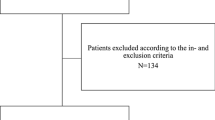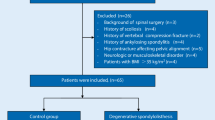Abstract
Purpose
This study aimed (1) to investigate the relationship between pelvic incidence (PI) and the anatomical acetabular anteversion (AA) relative to the spino-pelvic tilt (SPT) plane (anatomical AASPT), relative to the anterior pelvic plane (anatomical AAAPP), and functional standing AA; and (2) to compare AA and the sagittal spino-pelvic parameters of lumbo-pelvic complex types 1 (PI ≤ 30°) and 2 (PI > 30°), in Japanese females with hip osteoarthritis.
Methods
We conducted a retrospective study on 110 Japanese females with unilateral hip osteoarthritis. PI, standing lumbar lordosis (LL), standing SPT, anatomical AASPT, anatomical AAAPP, and functional standing AA were measured and calculated using radiographs and computed tomography. The PI-LL difference was defined as the mathematical difference between the PI and standing LL angles. Pearson’s correlation test was used to measure the relationship between the PI and AA. Student’s t test was used to compare spino-pelvic parameters between lumbo-pelvic complex type 1 (n = 24) and type 2 (n = 86).
Results
There was a significant relationship between the PI and anatomical AASPT (r = −0.532, p < 0.001), but no significant relationship between the PI and anatomical AAAPP (r = −0.021, p = 0.824) or functional standing AA (r = 0.104, p = 0.299). Lumbo-pelvic complex type 1 had a higher anatomical AASPT (22.4° ± 9.1° vs. 5.4° ± 15.1°, p < 0.001), similar anatomical AAAPP (15.0° ± 10.6° vs. 15.1° ± 15.3°, p = 0.981) and functional standing AA (12.4° ± 8.0° vs. 15.0° ± 14.1°, p = 0.254), a lower standing SPT (− 14.3° ± 11.0° vs. 13.7° ± 12.6°, p < 0.001), and a lower PI-LL difference (− 14.4° ± 18.5° vs. 6.4° ± 17.1°, p < 0.001) in comparison to lumbo-pelvic complex type 2.
Conclusion
Our findings will help to improve the understanding of hip anatomy and its relationship with the standing spino-pelvic alignment in Japanese females with hip osteoarthritis.





Similar content being viewed by others
Code availability
Not applicable to that section.
References
Boulay C, Bollini G, Legaye J, Tardieu C, Prat-Pradal D, Chabrol B et al (2014) Pelvic incidence: a predictive factor for three-dimensional acetabular orientation-a preliminary study. Anat Res Int 2014:594650. https://doi.org/10.1155/2014/594650
Buckland AJ, DelSole E, George S, Vira S, Lafage V, Errico T et al (2017) Sagittal pelvic orientation a comparison of two methods of measurement. Bull Hosp Jt Dis 75(4):234–240
Buckland AJ, Fernandez L, Shimmin AJ, Bare JV, McMahon SJ, Vigdorchik JM (2019) Effects of sagittal spinal alignment on postural pelvic mobility in total hip arthroplasty candidates. J Arthroplasty 34(11):2663–2668. https://doi.org/10.1016/j.arth.2019.06.036
Maillot C, Harman C, Villet L, Cobb J, Rivière C (2019) Modern cup alignment techniques in total hip arthroplasty: a systematic review. Orthop Traumatol Surg Res 105(5):907–913. https://doi.org/10.1016/j.otsr.2019.03.015
Morris WZ, Fowers CA, Yuh RT, Gebhart JJ, Salata MJ, Liu RW (2016) Decreasing pelvic incidence is associated with greater risk of cam morphology. Bone Joint Res 5(9):387–392. https://doi.org/10.1302/2046-3758.59.BJR-2016-0028.R1
Rivière C, Harman C, Parsons T, Villet L, Cobb J, Maillot C (2019) Kinematic alignment vs. conventional techniques for total hip arthroplasty: a retrospective case control study. Orthop Traumatol Surg Res 105(5):895–905. https://doi.org/10.1016/j.otsr.2019.02.012
Rivière C, Lazennec JY, Van Der Straeten C, Auvinet E, Cobb J, Muirhead-Allwoodc S (2017) The influence of spine-hip relations on total hip replacement: a systematic review. Orthop Traumatol Surg Res 103(4):559–568. https://doi.org/10.1016/j.otsr.2017.02.014
Sautet P, Giorgi H, Chabrand P, Tropiano P, Argenson JN, Parratte S et al (2018) Is anatomic acetabular orientation related to pelvic morphology? CT analysis of 150 healthy pelvises. Orthop Traumatol Surg Res 104(3):347–351. https://doi.org/10.1016/j.otsr.2017.10.006
Gebhart JJ, Streit JJ, Bedi A, Bush-Joseph CA, Nho SJ, Salata MJ (2014) Correlation of pelvic incidence with cam and pincer lesions. Am J Sports Med 42(11):2649–2653. https://doi.org/10.1177/0363546514548019
Legaye J, Duval-Beaupere G, Barrau A, Boulay C, Hecquet J, Montigny JP et al (2011) Relationship between sacral pelvic incidence and acetabular orientation. Hip Int 21(1):87–97. https://doi.org/10.5301/hip.2011.6283
Thelen T, Thelen P, Demezon H, Aunoble S, Le Huec JC (2017) Normative 3D acetabular orientation measurements by the low-dose EOS imaging system in 102 asymptomatic subjects in standing position: analyses by side, gender, pelvic incidence and reproducibility. Orthop Traumatol Surg Res 103(2):209–215. https://doi.org/10.1016/j.otsr.2016.11.010
Fujii M, Nakashima Y, Sato T, Akiyama M, Iwamoto Y (2012) Acetabular tilt correlates with acetabular version and coverage in hip dysplasia. Clin Orthop Relat Res 470(10):2827–2835. https://doi.org/10.1007/s11999-012-2370-z
Lazennec JY, Boyer P, Gorin M, Catonné Y, Rousseau MA (2011) Acetabular anteversion with CT in supine, simulated standing, and sitting positions in a THA patient population. Clin Orthop Relat Res 469(4):1103–1109. https://doi.org/10.1007/s11999-010-1732-7
Le Huec JC, Hasegawa K (2016) Normative values for the spine shape parameters using 3D standing analysis from a database of 268 asymptomatic Caucasian and Japanese subjects. Eur Spine J 25(11):3630–3637. https://doi.org/10.1007/s00586-016-4485-5
Lembeck B, Mueller O, Reize P, Wuelker N (2005) Pelvic tilt makes acetabular cup navigation inaccurate. Acta Orthop 76(4):517–523. https://doi.org/10.1080/17453670510041501
Weir JP (2005) Quantifying test-retest reliability using the intraclass correlation coefficient and the SEM. J Strength Cond Res 19(1):231–240. https://doi.org/10.1519/15184.1
Schober P, Schwarte LA (2018) Correlation coefficients: appropriate use and interpretation. Anesth Analg 126(5):1763–1768. https://doi.org/10.1213/ANE.0000000000002864
Funding
No funding was available for this manuscript.
Author information
Authors and Affiliations
Contributions
TK: Conception, design of the study, data collection, critically drafting and revising the article for important intellectual content, and final approval of the version to be submitted. TM: Conception and design of the study, critically drafting and revising the article for important intellectual content, and final approval of the version to be submitted. TY: Data collection and final approval of the version to be submitted. MS: Final approval of the version to be submitted. CR: Critically drafting and revising the article for important intellectual content and final approval of the version to be submitted. MM: Final approval of the version to be submitted.
Corresponding author
Ethics declarations
Conflict of interest
None of the other authors had conflict of interest related to the current study.
Ethics approval
All procedures performed in studies involving human participants were in accordance with the ethical standards of the institutional review board of Saga Medical University School of Medicine (registration number: 2017-11-R-04) and with the 1964 Helsinki declaration and its later amendments or comparable ethical standards.
Consent to participate
Not applicable to that section.
Consent for publication
All authors have seen and approved the final manuscript and have given their consent for publication.
Availability of data and material
The datasets used during the current study are not publicly available because of patient confidentiality but are available from the corresponding author on reasonable request.
Additional information
Publisher's Note
Springer Nature remains neutral with regard to jurisdictional claims in published maps and institutional affiliations.
Rights and permissions
About this article
Cite this article
Kobayashi, T., Morimoto, T., Yoshihara, T. et al. The relationship between pelvic incidence and anatomical acetabular anteversion in female Japanese patients with hip osteoarthritis: a retrospective iconographic study. Surg Radiol Anat 43, 1141–1147 (2021). https://doi.org/10.1007/s00276-021-02710-z
Received:
Accepted:
Published:
Issue Date:
DOI: https://doi.org/10.1007/s00276-021-02710-z




